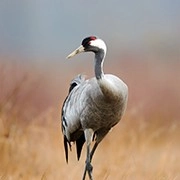Swans The Friendly Birds
The swan is a genus of waterfowl that has the ability to swim and fly with incredible speed and agility. This bird is also very intelligent, devoted to its mate, and highly aggressive about defending its young. They are a common sight in temperate and colder climates around the globe.
Swans are birds of the family Anatidae within the genus Cygnus. The swans' closest relatives include the geese and ducks. Swans are grouped with the closely related geese in the subfamily Anserinae where they form the tribe Cygnini. Sometimes, they are considered a distinct subfamily, Cygninae. There are six living and many extinct species of swan; in addition, there is a species known as the coscoroba swan which is no longer considered one of the true swans. Swans usually mate for life, although "divorce" sometimes occurs, particularly following nesting failure, and if a mate dies, the remaining swan will take up with another. The number of eggs in each clutch ranges from three to eight
There are six different types of swans
1.Mute swan - The mute swan is a species of swan and a member of the waterfowl family Anatidae. It is native to much of Eurosiberia, and the far north of Africa.
2.Black swan - Nomadic with erratic migration patterns dependent upon climatic conditions. Black plumage and a red bill.
3.Black-necked swan - The black-necked swan is the largest waterfowl native to South America.
4.Whooper swan - The whooper swan, also known as the common swan, pronounced hooper swan, is a large northern hemisphere swan. It is the Eurasian counterpart of the North American trumpeter swan, and the type species for the genus Cygnus.
5.Trumpeter swan - The trumpeter swan is a species of swan found in North America. The heaviest living bird native to North America, it is also the largest extant species of waterfowl, with a wingspan of 185 to 250 cm.
6.Tundra swan - The tundra swan is a small swan of the Holarctic. The two taxa within it are usually regarded as conspecific, but are also sometimes split into two species: Bewick's swan of the Palaearctic and the whistling swan proper of the Nearctic
Swans feed in water and on land. They are almost entirely herbivorous, although they may eat small amounts of aquatic animals. In the water, food is obtained by up-ending or dabbling, and their diet is composed of the roots, tubers, stems and leaves of aquatic and submerged plants
Swans famously mate for life, and typically bond even before they reach sexual maturity. Trumpeter swans, for example, who can live as long as 24 years and only start breeding at the age of 4–7, form monogamous pair bonds as early as 20 months. "Divorce", though rare, does occur; one study of mute swans showing a 3% rate for pairs that breed successfully and 9% for pairs that do not. The pair bonds are maintained year-round, even in gregarious and migratory species like the tundra swan, which congregate in large flocks in the wintering grounds.Swans' nests are on the ground near water and about a metre across. Unlike many other ducks and geese, the male helps with the nest construction, and will also take turns incubating the eggs
swans live across Europe and Asia, Australia and the surrounding islands, North America, Central America, and South America. Some species are more widespread than others, though many migrate long distances.
Today, estimates show about 16,000 trumpeter swans reside in North America, including some 13,000 in Alaska, which winter on the Pacific Coast; more than 1,600 in Canada; about 500 in the Midwest; and more than 500 in the tri-state area of Idaho, Wyoming, and Montana (including the Red Rock Lakes refuge flock).

 · Travel Team
· Travel Team